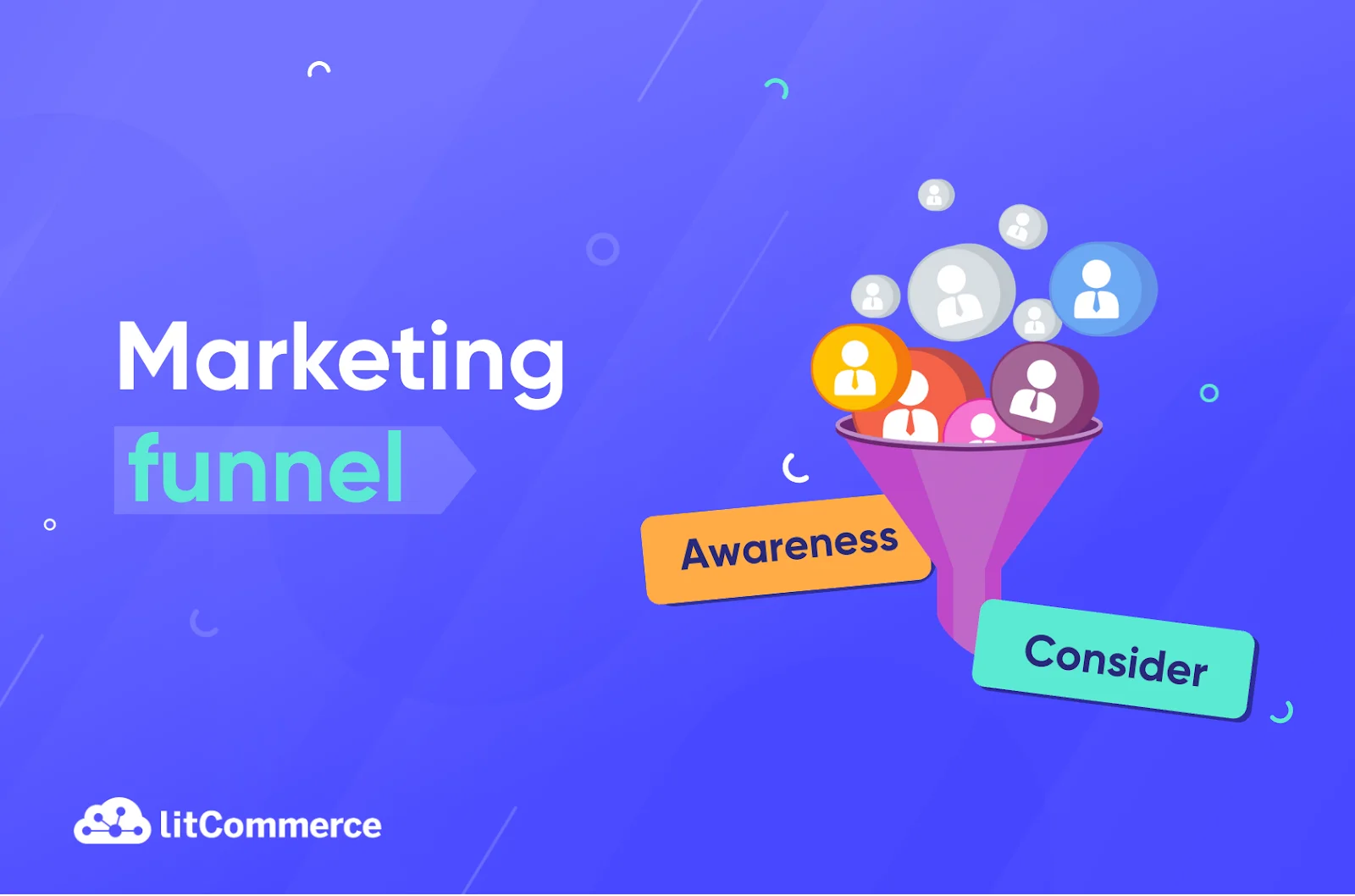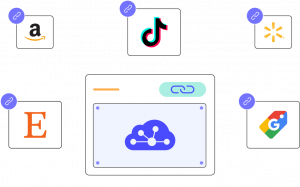A marketing funnel is one of the most powerful tools to turn potential customers into loyal ones. It maps out the entire journey, showing how people move from first hearing about your brand to making a purchase and beyond.
In this guide, you’ll find details on stages of the marketing funnel, case studies, and strategies you can apply right away. But before jumping into the details, here are some key takeaways.
Key takeaways
What is a Marketing Funnel?
A marketing funnel is a visual roadmap that potential customers go through from discovering your brand to making a purchase and becoming advocates.
In other words, it helps businesses understand and map out this journey so they can tailor marketing efforts to meet customer needs at each stage.
Moreover, by identifying where prospects drop off, businesses can refine their strategies and therefore boost conversions. This is particularly important today, as consumers interact with brands across multiple channels and touchpoints throughout their buying journey.
While various models exist, a common structure includes:
- Awareness (Top of Funnel – TOFU)
- Consideration/Interest (Middle of Funnel – MOFU)
- Conversion (Bottom of Funnel – BOFU)
- Loyalty/Advocacy (Post-Conversion)
Marketing funnel vs sales funnel
While A marketing funnel is all about attracting people, teaching them about your brand, and building trust until they’re ready to buy, a sales funnel starts once those people are interested enough to be called leads.
A sales funnel is the process that focuses on converting qualified leads into customers through direct engagement, negotiation, and closing sales. It represents the steps a sales team takes to move prospects through to a decision and purchase.
Here’s a comparison of the digital marketing funnel and sales funnel across key aspects:
Aspect | Marketing funnel | Sales funnel |
Purpose | Attracts and nurtures potential customers | Converts leads into paying customers |
Focus | Brand awareness, engagement, lead generation | Sales conversions, customer decision-making |
Stages | Awareness → Consideration → Conversion → Loyalty | Awareness -> Interest -> Decision -> Intent -> Evaluation and action -> Loyalty and retention |
Customer interaction | Minimal or indirect until later stages | High and direct contact, personalized communication |
Key activities | Content marketing, ads, social media, SEO, email campaigns | Sales calls, demos, negotiations, follow-upsKey metrics |
Key metrics | Impressions, reach, leads, click-through rate, conversion rate | Qualified leads, conversion rate (lead to sale), closed deals |
Tools | SEO tools, content platforms, ad networks | CRM, sales automation, demos, and direct communication tools |
Outcome | Generate leads and build brand interest | Close sales and manage customer relationships |
Relationship to each other | Marketing generates leads that feed into the sales funnel | Sales funnel converts those leads into customers |
Key takeaways
The marketing funnel builds awareness and generates leads through broad, content-driven activities. The sales funnel then engages these leads directly, guiding them through negotiation and purchase to close sales. Marketing focuses on content and data, while sales focuses on personal interaction and deal-closing.
Along with other strategies to grow your brand, don’t miss this Cross-Promotion: Strategies, Types, and Real Examples (2025)
Compare B2B vs B2C marketing funnel
After differentiating between marketing and sales funnels, it is helpful to see how marketing funnels differ by business type. Specifically, B2B (business-to-business) and B2C (business-to-consumer) audiences behave differently.
Below’s a comparison of B2B vs B2C marketing funnel highlighting their differences:
Aspect | B2B | B2C |
Buying cycle length | Longer, weeks to months, multiple touchpoints needed | Shorter, minutes to hours, fast buying decisions |
Decision-makers | Multiple stakeholders and decision-makers are involved | Individual buyers or small personal influence (family, friends) |
Content strategy | Focus on educational content, including whitepapers, case studies, and reports | Focus on engaging content such as videos, social media, and influencer marketing |
Sales approach | Relationship-driven: email, networking, 1-on-1 communication | Automated: ads, flash sales, influencer marketing |
Customer retention | Long-term focus: support, account management | Incentives-driven: loyalty programs, discounts |
Conversion focus | Demonstrates ROI, builds trust with the ability to solve problems | Emotional appeal, impulse buying, strong brand presence |
Funnel complexity | More complex with multiple stages due to team involvement | Simpler, direct path to purchase |
Lead nurturing | Extended nurturing with personalized outreach | Quick engagement and prompt calls to action |
Key takeaways
B2B marketing funnel are longer, more personalized, and education-based to accommodate a complex buying process with multiple stakeholders. In contrast, B2C funnel focus on quick, emotion-driven conversions and mass outreach with simpler paths to purchase.
Why Should You Use a Marketing Funnel?
A marketing funnel is essential because it helps you reach the right people, use your resources effectively, and build long-term customer loyalty.
Using this funnel helps you attract the right audience, guide them through their decision-making process, and turn them into loyal customers. It gives you a structured view of the customer journey so you can deliver the right message at the right time, reducing drop-offs and increasing conversions.
A funnel also ensures your resources are spent wisely. By pinpointing where prospects are most likely to lose interest, or where they’re closest to buying, you can focus your efforts where they’ll have the biggest impact, maximizing return on investment.
Beyond driving sales, a digital marketing funnel also builds stronger customer relationships. With the right nurturing, you can encourage repeat purchases, foster loyalty, and even turn happy customers into advocates for your brand.
Marketing Funnel Stages, Strategies, and Metrics to Track
A marketing funnel guides potential customers through a clear journey, from first discovering your brand to becoming loyal advocates.
Let’s break down the four key marketing funnel stages, the strategies you can use at each step, and how to check their success.
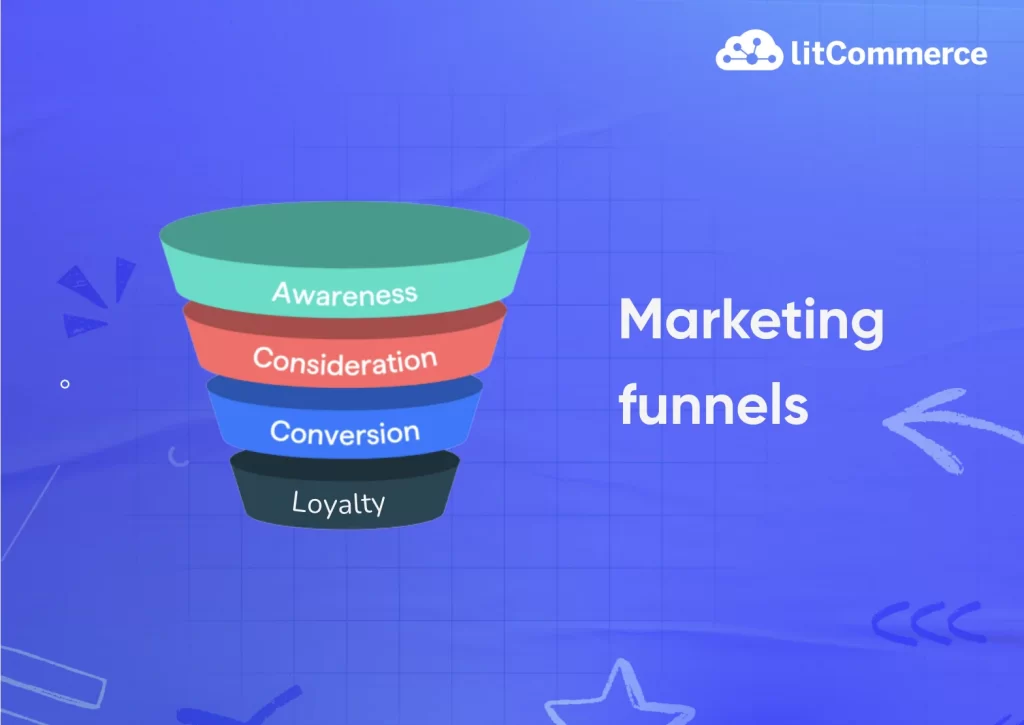
Awareness stage
The Awareness stage is the top of the funnel (TOFU), where the goal is to attract as many relevant prospects as possible by introducing them to your brand, product, or service.
At this awareness stage, most potential customers don’t yet recognize their problem, or they aren’t aware that your solution exists. It means your content must focus on visibility, education, and strong first impressions. During this stage, you’re not selling aggressively. Instead, you’re helping people discover something useful, interesting, or entertaining so they begin associating your brand with value.
For example, on this first stage, a fitness brand posts a 30-second TikTok video showing a person using their smart fitness tracker to monitor heart rate during a workout. The video goes viral, reaching 50,000 viewers and introducing the brand to potential customers.
This video works because it focuses on broad visibility rather than selling. A short TikTok video showcasing the fitness tracker in action reaches 50,000 viewers, introducing the brand to people who may not know they need it yet.
Strategies for the awareness stage
- Publish accessible, high-value content such as blog posts, shorts, infographics, and educational videos that align with common challenges or interests your audience has. Focus on being helpful, not salesy
- Optimize for SEO so your brand can rank higher on search engines.
- Run social media campaigns with engaging posts, stories, or reels, using both organic reach and paid ads, such as Facebook Ads, TikTok ads, to boost visibility.
- Engage in public relations efforts, such as press releases or guest appearances on podcasts, to boost brand visibility.
Key metrics to track: Website traffic (unique visitors), social media impressions and reach, ad click-through rates (CTR), and brand mentions or shares.
Combine organic and paid tactics to reach new audiences, explore more practical ideas in How to Promote Your Business: 29 Free & Paid Strategies.
Run your Ads Smoothly Using LitCommerce
LitCommerce makes it easy to create product feeds to advertise on Facebook, Google Shopping, and 350+ channels, ensures they meet ad requirements with smart checks, and keeps them updated automatically with feed syncs.
Consideration stage
The next stage on the online marketing funnel is the consideration stage.
This stage is when prospects are actively comparing your product or service with other options. They already understand their problem and are exploring solutions, so your goal is to show that your offering is the best fit.
At this stage, potential customers know what they want, but they’re still deciding which brand can offer the best results, value, and experience. Your main goal here is to build trust, answer questions, reduce doubts, and clearly show why your product or service stands out from the competition. During this stage, buyers start looking for proof: real experiences, expert insights, transparent comparisons, and anything that helps them feel confident about choosing you.
Example: Imagine this, the business selling handcrafted leather notebooks displays a customer review on their website from a writer who loves the notebook’s premium feel and long-lasting leather cover. A potential buyer reads the review while comparing it to cheaper notebooks.
This strategy provides social proof at the exact moment a buyer is evaluating alternatives, reducing hesitation by showing that real users value the quality. It makes the prospect more confident in choosing the handcrafted option.
Strategies for the consideration stage:
- Share authentic social proof, such as customer reviews, testimonials, case studies, or before-and-after results, to demonstrate real-world value.
- Offer free trials, live demos, or interactive walkthroughs to let prospects experience your product firsthand.
- Use retargeting ads (e.g., Meta, Google, TikTok) to reach people who visited your website but didn’t convert. These reminders reinforce your core benefits at the right time.
- Create comparison-focused content, such as “Product A vs. Product B” blog posts, feature breakdowns, or demo videos that address objections and highlight your advantages clearly.
- Send personalized emails or chat messages that address specific concerns, recommend suitable options, or answer questions based on user behavior.
Key metrics to track: Engagement with case studies or demo videos, such as content downloads, free trial sign-ups, or demo bookings, and retargeting ad conversions.
Conversion stage
The Conversion stage is where prospects become paying customers. At this point, your priority is to remove friction, reinforce trust, and provide the final push that helps someone complete their purchase.
Every element of the buying experience should guide the user toward a confident “yes,” including clear CTAs, transparent pricing, fast checkout, and reassuring guarantees.
Your goal here is to make the buying process smooth, persuasive, and risk-free. This includes addressing last-minute doubts, using strong value reminders, and offering incentives that make the decision feel both smart and timely.
For example, imagine an online clothing retailer launching a new line of sustainable dresses. The landing page highlights a clear “Shop Now” button, showcases customer reviews, and offers a 15% discount pop-up for first-time buyers.
A visitor adds a dress to their cart but leaves the site. Later, they receive a cart abandonment email with a 24-hour discount code, which encourages them to complete the purchase.
This example shows how timely incentives and strong CTAs can turn interest into action. The cart-abandonment email provides an extra nudge at the exact moment hesitation occurs, increasing the likelihood of completing the purchase.
Strategies for the conversion stage:
- Design optimized landing pages with clear calls-to-action (CTAs), trust signals like reviews, and minimal distractions.
- Introduce limited-time offers, discounts, or exclusive bonuses to encourage immediate action.
- Simplify the checkout process with minimal steps, guest checkout options, and multiple payment methods.
- Send automated emails or SMS reminders to prospects who added items to their cart but didn’t complete the purchase.
- Suggest complementary products or upgrades during the checkout process to increase average order value.
Key metrics to track: Conversion rate (percentage of visitors who purchase), average order value, cart abandonment rate, and revenue per visitor.
Loyalty stage
The loyalty stage is where the focus shifts to transforming one-time buyers into repeat customers and brand advocates.
The primary goal of this stage is to foster long-term customer retention, build strong relationships, and encourage advocacy by delivering exceptional post-purchase experiences and maintaining consistent engagement.
This ensures customers remain satisfied, return for future purchases, and promote your brand to others, amplifying your reach and reputation.
For instance, a coffee subscription service sends a personalized thank-you email to a customer after their first order, including a brewing guide and an invitation to join a loyalty program where they earn points for every purchase.
After three orders, the customer redeems points for a free coffee sample and shares a photo of their morning brew on Instagram with the brand’s hashtag, #BrewWithUs, which gets featured on the brand’s official page.
Here are some strategies you can apply during the loyalty stage:
- Ensure the purchase process is smooth, with clear communication about order confirmation, shipping updates, and delivery timelines.
- Deliver on promises by providing high-quality products or services that meet or exceed customer expectations.
- Develop ongoing email sequences that offer value, such as exclusive content, product tips, or updates about new features or offerings.
- Do post-purchase follow-up by ending personalized thank-you emails, requesting feedback, etc, to keep your brand top of mind.
- Implement rewards programs, such as points-based systems or tiered memberships.
- Provide responsive, empathetic customer service through multiple channels (e.g., live chat, email, phone)
Key metrics to track: Customer retention rate, repeat purchase rate, customer lifetime value, customer satisfaction score.
Marketing Funnel Case Study
To see how the marketing funnel works in practice, let’s look at real brands that guide their customers from awareness to loyalty. These case studies show how various strategies at each stage can attract, convert, and retain loyal customers.
Nike
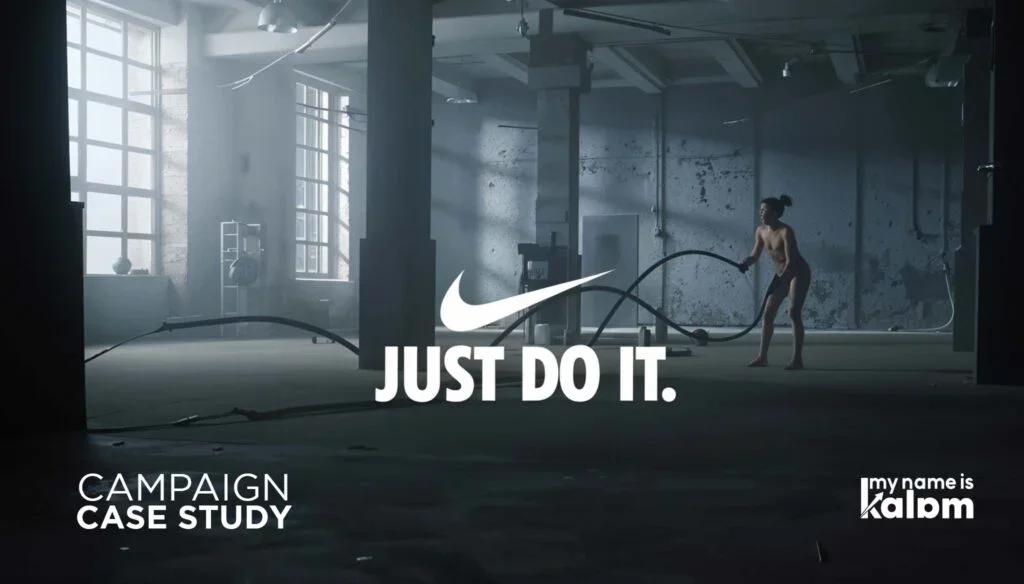
Nike builds brand recognition through iconic campaigns like “Just Do It” and athlete partnerships that sell a lifestyle, not just products. At the same time, it provides value with workout guides, blogs, and the Nike Training Club app—keeping audiences engaged and positioning itself as a trusted fitness authority.
When prospects are comparing options, Nike supports their decision-making with detailed product information, athlete endorsements, and customer reviews. Features like product customization and filters by sport or activity help users find the perfect fit.
To drive purchases, Nike removes friction with free shipping, exclusive offers, and a streamlined checkout process. Targeted email campaigns add urgency with limited-time deals and product launches.
Post-purchase, Nike strengthens loyalty through its membership program, early access to new releases, event invitations, and personalized content delivered via apps, email, and push notifications.
AirBnB
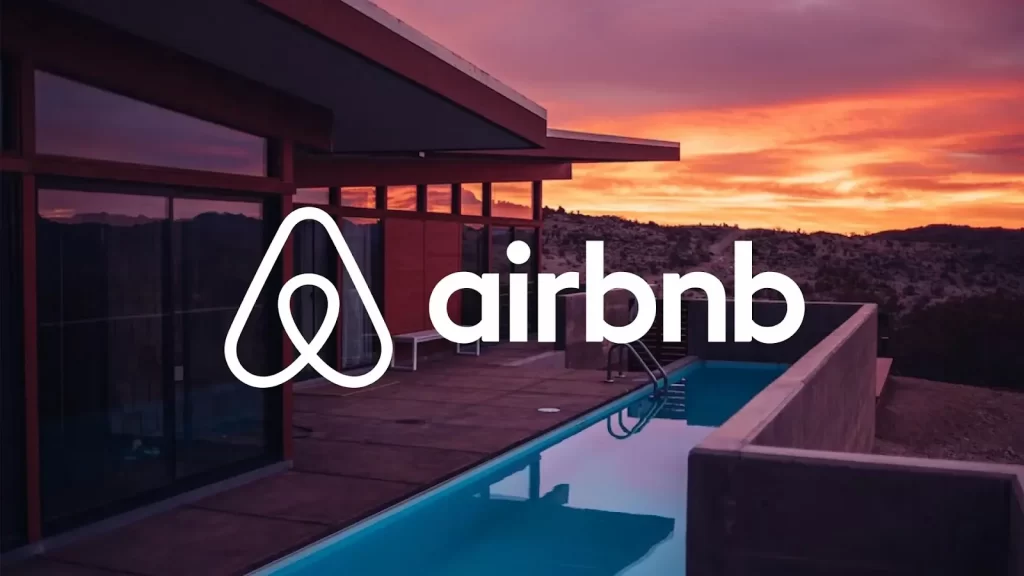
Airbnb builds global recognition through storytelling, influencer partnerships, and social sharing. The brand highlights real travel experiences and hosting success to inspire both guests and hosts.
Moving into the consideration stage, the focus shifts to trust. Guests gain confidence through reviews, high-quality photos, and direct messaging with hosts, while hosts benefit from pricing tools, protection plans, and onboarding guides. Testimonials from both sides further strengthen credibility.
During the conversion stage, Airbnb makes the booking process smooth and compelling. Users can rely on smart filters, flexible payment options, and retargeting ads to complete their reservations with ease.
Finally, Airbnb works to keep users engaged and loyal. Personalized travel ideas, referral rewards, and consistent post-booking communication encourage both travelers and hosts to return for future experiences.
Spotify
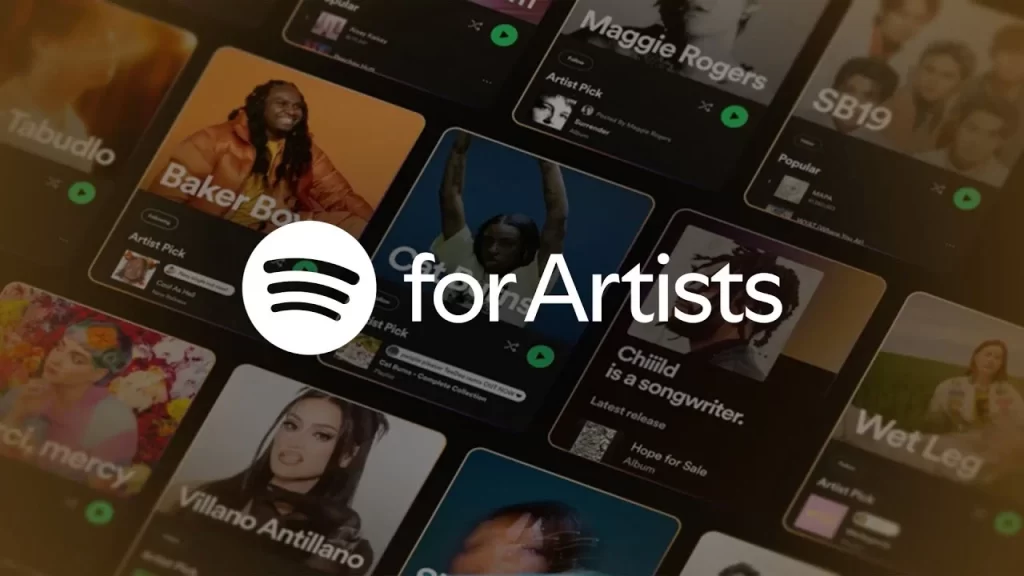
In the awareness stage, Spotify reaches new audiences through social media campaigns, influencer partnerships, and collaborations with artists. Memorable ads, like “Wrapped,” spark curiosity and encourage people to share their listening habits online.
During the consideration stage, Spotify positions itself as the best option by offering personalized playlists, free trials, and side-by-side comparisons with competitors. User reviews, recommendations, and artist-curated playlists further build trust and interest.
At the conversion stage, Spotify encourages users to upgrade from the free plan to Premium. It removes friction with flexible pricing, student discounts, family plans, and limited-time offers that make subscribing easy and appealing.
Finally, in the loyalty stage, Spotify strengthens loyalty through features like Spotify Wrapped, personalized playlists, and exclusive early access to music or podcasts. Push notifications, emails, and AI-driven recommendations keep users engaged and less likely to churn.
Marketing Funnel Explained: FAQs
How do I create a marketing funnel?
To create a marketing funnel, follow these key steps:
1. Identify your audience: Understand your target audience’s demographics, behaviors, and preferences to tailor your marketing efforts effectively.
2. Set objectives: Define specific, measurable, and achievable marketing goals aligned with your business.
3. Choose channels: Select marketing channels where your target audience is most active.
4. Create content: Develop compelling content for each stage of the funnel that addresses audience needs and guides their decision-making.
5. Measure and optimize: Continuously analyze funnel performance and refine your strategies for better results.
What are the 4 stages of the marketing funnel?
The four common stages of the marketing funnel are Awareness, Consideration, Conversion, and Loyalty. These stages represent a customer’s journey, starting with their discovery of a brand (Awareness), moving to evaluating options (Consideration), making a purchase (Conversion), and finally becoming a repeat, dedicated customer (Loyalty).
What is an example of a marketing funnel?
An example of a marketing funnel is Spotify’s funnel: ads and social sharing create awareness, free trials drive consideration, discounts encourage conversion, and personalized playlists help retain users.
What is the difference between a marketing funnel and a sales funnel?
The marketing funnel builds awareness and generates leads through broad, content-driven activities. The sales funnel then engages these leads directly, guiding them through negotiation and purchase to close sales. Marketing focuses on content and data, while sales focuses on personal interaction and deal-closing.
Start Creating a Marketing Funnel That Converts Today!
Building a marketing funnel is one of the most effective ways to turn strangers into loyal customers. By guiding prospects through each stage, from awareness to retention, you can create a smoother customer journey, enhance conversions, and sustainably grow your business.
This article has walked you through the definition of a marketing funnel, practical strategies, and real-world case studies to help you design one that works for your business.
Need more marketing tips or expert guidance? Visit our Blog or Contact us for further assistance. We’re here to help!

